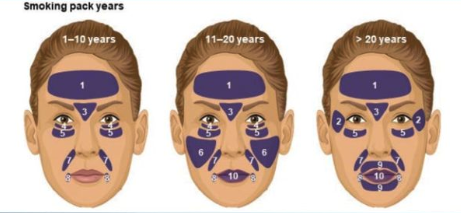Crow’s feet, under-eye puffiness and reduced lip fullness are just some of the premature facial ageing effects of smoking and drinking in women, an Australian dermatologist has warned.
An international study led by Melbourne dermatologist Dr Greg Goodman has confirmed a ‘dose response’ relationship between smoking levels and premature ageing of the skin in women.
The study – based on self-assessment of skin features and self-reporting of smoking and alcohol consumption by 3,267 women – also showed negative effects of heavy alcohol use. Based on questionnaire responses from women in Australia, the UK, US Canada, the associations adjusted for confounding factors such as age, country of origin and BMI.
Increasing levels of smoking, as rated by number of pack years, was associated with significant increases in severity of forehead, crow’s feet, and glabellar lines; under-eye puffiness; tear-trough hollowing; nasolabial folds; oral commissures; perioral lines; and reduced lip fullness compared to non smoking. However smoking was not associated with increased midface volume loss or visible blood vessels.
 Certain features – such as crow’s feet, tear troughs, and perioral lines were more likely to increase in severity with longer duration and greater amount of smoking.
Certain features – such as crow’s feet, tear troughs, and perioral lines were more likely to increase in severity with longer duration and greater amount of smoking.
The severity of most measures of facial ageing was greater in former smokers compared to current smokers, presumably due to longer duration of exposure to smoking, the study investigators said. This also showed that favial ageing was not reversed by smoking cessation, they added
Heavy alcohol use (more than 8 drinks/week) was associated with significantly increased upper facial lines, under-eye puffiness, oral commissures, midface volume loss, and blood vessels. Among moderate drinkers, only midface volume loss and under-eye puffiness were associated with drinking.
Dr Goodman, a dermatologist Skin & Cancer Foundation in Victoria, said the findings backed up those of smaller studies and suggested that “free radicals and reactive oxygen species generated by smoking might induce aging changes not only in the epidermis and dermis (e.g., by impairing collagen biosynthesis and causing collagen degradation via the induction of matrix metalloproteases) but also in the fat (i.e., volume-related features).”
“As facial volume decreases, features like tear troughs and infraorbital fat pads (puffiness) become more prominent,” Dr Goodman and co-authors noted.
For alcohol use, other studies had provided conflicting findings on the impact on skin ageing, the authors said, possibly due to how alcohol consumption was measured.
Excessive alcohol consumption might impact on skin appearance via vitamin deficiency, tissue damage, disruption of inflammatory responses, and diminished ability of skin fibroblasts to produce type I collagen).
“Alcohol abuse has been reported to reduce fat mass, which might underlie the midface volume loss reported by heavy drinkers. The increased under-eye puffiness might have been due to the unveiling of the suborbital fat pad as the midface volume receded,” they wrote.
“We herein provide dermatologists with empirical data to support recommendations to their patients on lifestyle modification—namely, that never smoking and not exceeding moderate alcohol consumption can help to delay the onset of the appearance of facial ageing,” they concluded.
“If they already smoke, patients (especially the young) should be advised to stop, because aging severity increases with the amount and duration of tobacco exposure.”
The findings are published in the Journal of Clinical and Aesthetic Dermatology.